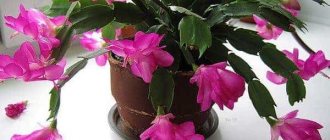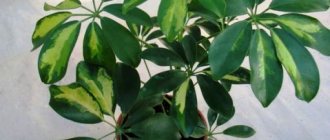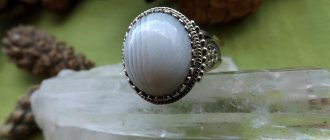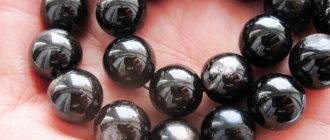Among the rich splendor of exotic flowers, one of the most striking representatives is arrowroot. This plant can decorate any interior thanks to its original, sophisticated appearance. Large velvety leaves from pale green to greenish-blue colors are decorated with intricate patterns, veins, and spots.
The plant was named after the scientist and healer Bartolomeo Maranta, who discovered this amazing flower in search of antidotes. Due to its ability to lift and curl the leaves in the evening, as if joining palms in prayer, arrowroot received the name - prayer grass. Arrowroot is especially respected by the British, due to the presence of ten spots on the leaf of the plant, which is associated with the “Ten Commandments”; one of the types of arrowroot was called Kerkhoven’s Maranta.
It is believed that by getting this flower, you can attract happiness, prosperity and prosperity into your life . Along with such unusual properties of this delicate flower, the signs and superstitions associated with it are also unusual.
What does the flower symbolize?
The tropical plant is popular due to its medicinal properties and external characteristics. The flower is distinguished by variegated leaves and a height not exceeding 25 cm. Flowering occurs in the summer.
Maranta can decorate any home and create an atmosphere of comfort. Experts in the field of esotericism recommend finding out known signs and superstitions before asking for a sprout or buying a plant in a flower shop.
If you follow all the rules of cultivation, you can attract happiness, prosperity and prosperity into your life. However, one must also take into account superstitions and signs.
Maranta symbolizes success and attracts financial stability. Since ancient times, people have considered the flower suitable for creating harmony in family relationships.
White-veined arrowroot (M.leuconeura)
White-veined arrowroot grows in natural conditions in tropical forest areas with high humidity. The root system is tuberous. The stem part is up to 25-30 cm high. The foliage is rounded-elliptical, with a heart-shaped base. A red or bluish-green color is observed on the underside of the leaf blade. The surface of the leaves has a light green pattern and white veins, clearly visible against the rich green background. In home floriculture, the Massanja variety of arrowroot is especially popular, and the tricolor or red-veined arrowroot.
Magical properties of the plant
If we talk about signs and superstitions, arrowroot is considered a favorable plant for growing at home. The beneficial qualities and properties of arrowroot allow it to be placed in offices.
According to superstitions and signs, it is recommended to place the flower near the bed in the bedroom to restore the harmony of intimate relationships. The flower helps children and adults keep their emotions under control and eliminate laziness. Arrowroot helps to reveal abilities.
Arrowroot strengthens the immune system due to the content of B vitamins. The plant purifies the air, which has a beneficial effect on the general condition of household members. The leaves contain starch and are used as food for anemia and anorexia. Tubers are used in cooking for making confectionery products. However, the use of leaves internally is possible only after consulting a specialist.
Maranta lifts its leaves before a thunderstorm. This property is also observed in insufficient indoor light and unfavorable growing conditions. The flower seems to be asking for proper care, for which it was also called a praying grass.
Attention! The plant is not poisonous.
Photo gallery
People awarded the second plant because one of its varieties has ten white spots on the leaves. Belongs to the Marantov family.
Arrowroot is not poisonous; you can safely transplant a flower without gloves. The plant does not require special care. The main thing is to maintain the temperature regime, water it abundantly, cut off dry leaves and replant it 2 times a year, in the spring.
Select a medium-sized pot - arrowroot does not have a very large root system. It has a positive effect on people: it perfectly purifies the air and improves sleep.
If you want to buy a flower that is similar to arrowroot, then ctenantha or calathea are excellent choices. The greatest similarity with praying grass is observed in the popular variety of ctenanta - lubbers. There are slight differences in appearance and methods of propagation - arrowroot propagates by shoots, and calathea by dividing the bush.
Is it possible to keep arrowroot at home?
Signs and superstitions say that arrowroot can be grown at home. An exotic flower protects against quarrels and eliminates aggression when the pot is placed correctly.
The plant benefits both adults and children. In order for the flower to release good energy, the flowerpot should be placed in the corner of the room. The sun's rays must penetrate into this place.
Attention! You can expect good omens to come true only if the pot is adequately positioned.
Maranta is not demanding to care for. Untimely watering does not cause the plant to wither. Thus, a poor state indicates a person's poor perception of change. According to superstition, fading occurs when the owner is irreconcilable with the opinions of those around him. You should think about changes in a positive way, so that praying grass will help you cope with quarrels and problems that arise.
Reed arrowroot (M.arundinacea)
Reed arrowroot is a shrub plant reaching a height of one meter. The root system is tuberous and fairly well developed. The foliage is ovate, with a slight point at the apical part. The lower leaf blade is dark green, with short, frequent hairs. Reed-like arrowroot blooms quite rarely, with whitish flowers.
Signs and superstitions about arrowroot
According to signs and superstitions, arrowroot can bring well-being and prosperity (spiritual, financial) to the home. In addition, praying herb drives away thoughts of adultery, strengthening the marriage.
Blooming can be considered a good omen. The appearance of flowers indicates profit, as well as a new addition to the family.
Attention! An improvement in financial situation occurs if the person who earns the most in the family takes care of the praying grass.
Signs and superstitions say that praying grass can be propagated. Each family member should receive and root their own cuttings. After 2 weeks you can expect a full-fledged plant.
Who can I give a flower to?
Since arrowroot is an unpretentious plant, distinguished by good omens and superstitions, it can be given as a gift for growing at home and in the office. The potty is placed in the living room, bedroom, children's room and office. Arrowroot calms, eliminates excessive excitement, fatigue, and allows you to achieve stability.
Praying grass is a great gift for the elderly. It gives a surge of strength and energy, a desire to live. Esotericists recommend giving the plant as a gift to teenagers. The flower normalizes the psychological situation and allows you to decide on the choice of profession.
Important! In China, praying grass is an integral element of decoration.
Where is the best place to put the plant?
Experts emphasize that there are no known bad omens or superstitions about arrowroot. That is why the flower is recommended for growing at home and in office spaces.
It is a common superstition that praying herb helps strengthen family relationships. For this purpose, the pot is placed near the bed. The plant helps with lack of satisfaction from intimacy. Maranta eliminates quarrels and misunderstandings between spouses, loves warmth and light. The temperature should not fall below 23-25 °C. In spring and summer, abundant watering is required. Dry leaves indicate not only a bad omen, but also insufficient care.
Important! It is advisable to place the flowerpot in the room of people with weak energy.
How to avoid the consequences predicted in signs
There are no bad omens or superstitions about the flower. Praying herb purifies the air in the room, normalizes the energy in the house, eliminates nervousness and promotes the development of abilities. When placed in the bedroom, the flower improves intimate relationships between spouses and promotes quality deep sleep.
However, to avoid possible consequences, it is necessary to ensure proper care with abundant watering in the spring and summer. Usually the death of a flower is considered a bad omen. You should pay attention to the condition of the leaves, which indicates errors in care.
Temperature, lighting and comfortable location
Indoor arrowroot loves warmth, so in summer the temperature should be 20-25°C. In winter - about 17-18°C. The plant is afraid of drafts, and if it is under their influence, it immediately begins to dry out. A pot with a heat-loving flower cannot be placed on the windowsill. In the warm season, arrowroot can be taken outside, but always in the shade, not blown by the wind.
From October to February the plant has a rest period. During this period, the temperature is 18-20 °C. The main thing is to avoid sudden changes in temperature.
In direct sunlight, its leaves turn pale. The plant feels best in partial shade, with diffused light. The ideal option is a stand in the center or at the back of the room.
Popular beliefs
- Maranta is considered a flower of monetary well-being, a magnet for attracting finance. The appearance of arrowroot in the house can contribute to promotion on the career ladder, receiving a sudden bonus, a large gift, winning the lottery, and it can also prevent unnecessary spending.
- There is also a belief that for financial well-being, the flower must be looked after by the person who earns the most in the family. There is also an opinion that praying grass needs to be propagated; each family member must personally plant a cutting of the plant.
- Maranta helps strengthen family relationships, drives away thoughts of adultery, and strengthens marriage. If you place a flower in the bedroom, it will contribute to harmony in the relationship between spouses, a surge of passion, and satisfaction from intimacy.
- The flower also has a beneficial effect on children. If a child is too conflicted, lazy, or disobedient, then close proximity to the arrowroot will allow these problems to be resolved. It helps teenagers smooth out rough edges in communication during the period of personality formation and decide on the choice of a future profession. Maranta corrects behavior, creates a favorable creative environment, reveals talents, thanks to which creative individuals will experience a surge of inspiration.
- Arrowroot helps strengthen the immune system due to its ability to bring clean air into the house, which improves health. The proximity of arrowroot is beneficial for older people who have health problems - the flower will help them recover quickly, give them a new surge of strength and the desire to live. Arrowroot is able to stabilize the energy situation, relieves stress and promotes good sleep.
- There is also a sign associated with the general condition of the flower. The withering of the plant signals that a negative atmosphere has developed in the house, despondency has settled, an unwillingness to forgive, make concessions, and listen to the wishes of loved ones. Sometimes the poor condition of a plant promises large financial losses and damages. As soon as the situation improves, the health of the flower will be restored.
Why does it bloom?
The blossoming of a flower, which is very rare, is truly considered a very good omen. If the arrowroot has bloomed, then this promises a big profit or an addition to the family .
Why do you dream?
If arrowroot is present in your dream, then changes in your personal life await you, the imminent appearance of a person with whom only happy and unforgettable moments will be associated. The presence of people in such a dream means that you will become a participant in a wedding or birthday party. The presence of animals near the arrowroot promises a meeting with old friends.
A plant endowed with only positive characteristics is undoubtedly a must-have in your home. It will attract happiness and harmony to you, help improve your quality of life, get rid of negativity, protect you from quarrels and eliminate aggression. Think positively and praying grass will help you cope with all adversities.
Is it possible to keep the plant at home?
Arrowroot (including tricolor) is completely safe for the home and is not poisonous. It has no toxic juice, does not emit harmful fumes , and is harmless even for allergy sufferers. You can safely get this flower if you have furry pets, who like to chew on plants, and also without worrying about placing it in the bedroom where small children sleep. This will encourage them to sleep soundly and behave well.
Benefits of the flower
Arrowroot benefits adults and children. This low-maintenance flower with positive reviews can be an excellent gift for home and office.
Give arrowroot:
- For friends who have a child , the baby will be obedient and talented.
- For elderly relatives , the plant will protect them from serious diseases.
- Newlyweds and married people - to strengthen their family ties.
- For singles , the gift will serve as a wonderful decoration for their home and will increase their budget, and maybe they will finally meet their soulmate.
Due to its chemical composition, arrowroot has a number of medicinal properties . Flowers are used as a dietary and tonic, treatment and prevention of vein disease. The root is used to prepare baby food for children suffering from carbohydrate metabolism disorders.
Arrowroot roots are widely used in cooking . The roots of one of the subspecies of this flower are ground into flour (arrowroot) and used not only as a dietary food, but also as thickeners for sauces and jellies.
Even in ancient times, Indian tribes used Arrowroot powder as an antidote against poisoned arrows.
Benefits for the body
Sometimes this plant is used for food. But in this case, you should be careful, because sometimes it can be beneficial, and sometimes, on the contrary, it can be harmful.
Benefit:
- Arrowroot tubers are rich in starch, which makes it useful for anemia and anorexia.
- The high content of vitamins helps strengthen the immune system and maintain health.
- The tubers of this plant are used as a food additive in confectionery products, which makes them more nutritious.
Harm:
- Before eating arrowroot, you should make sure that there is no intolerance to any of the components.
- For a certain period of time after surgery, flour from this plant is contraindicated.
- If you have a stomach ulcer, eating arrowroot in any form is prohibited.
As for keeping arrowroot at home as an ornamental plant not intended for food, there are no obstacles to this, it is harmless.
Growing technology
Care at home involves following basic agrotechnical practices, as well as maintaining temperature conditions and providing plants with comfortable humidity levels.
Landing capacity
The not very developed root system of the ornamental plant requires cultivation in medium-sized flower pots. The best option for growing are plastic planting containers with a diameter equal to the height of the ornamental crop. A flower pot must have very high-quality drainage holes to prevent moisture stagnation at the root system.
Arrowroot cuttings (video)
Soil for growing
For good growth and development of arrowroot, as well as timely flowering, it is recommended to use for planting and growing an ornamental crop a nutritious soil substrate based on leaf soil, peat chips, high-quality humus and coniferous soil with the addition of a small amount of medium-grained sand and crushed charcoal.
Transplanting a plant
It is advisable to replant arrowroot no more than once every three years. The plant does not tolerate transplantation very well, so it is considered optimal to carry out the event in early spring. The dimensions of the flower pot should allow the root system of the ornamental plant to occupy a horizontal position. During the replanting process, it is imperative to conduct a thorough inspection of the root system and above-ground parts of the plant, and, if necessary, remove damaged or wilted leaves and roots. It is imperative to fill in a relatively high layer of drainage based on broken bricks, charcoal and coarse sand.
Feeding and watering
Arrowroots need timely application of fertilizers. As a rule, fertilizing of decorative foliage crops is carried out from early spring to the last days of summer. For this purpose, ready-made mineral fertilizers are applied twice a month, which are recommended to be alternated with organic matter.
Irrigation measures are carried out as the top layer of soil in the flower pot dries out. In the autumn-winter period, it is advisable to alternate watering with spraying. For humidification, well-settled water at room temperature is used. A good result is obtained by using melted or boiled water.
Temperature and humidity
In the room for growing ornamental plants, arrowroot should be provided with comfortable temperature and air humidity. The optimal condition for cultivating a houseplant is a temperature of 20-25°C in the spring-summer period and about 18-19°C in the autumn-winter period. Arrowroot is very difficult to tolerate the negative effects of drafts, so the location of the indoor crop must be chosen very carefully.
The botanical features of arrowroot and the characteristics of the natural growing conditions of this ornamental plant suggest creating air humidity in the growing room at a level of 85-90%. To create such indicators, you should combine regular, fairly abundant irrigation measures and periodic spraying of the aboveground part of the plant. However, it is important to completely eliminate stagnation of moisture in the soil, since in this case rotting of the root system of the crop may occur.
Disease Prevention
If cultivation is not carried out correctly and care technology is not followed, the foliage may be affected by brown spot, and the roots of the plant may suffer from rotting. In this case, the plant is treated with a weak solution based on potassium permanganate and replanted with soil replacement.
In conditions of low humidity, the leaves curl and dry out , and to correct the situation, mineral fertilizing and an increase in air humidity are carried out. Also, amateur gardeners quite often encounter rotting and wilting of flower stalks as a result of exposure to low temperatures or excessive soil moisture in a flower pot. Among other things, ornamental crops may require shading on days that are too sunny, which will prevent the foliage from getting burned.
Feng Shui meaning
Recently, growing plants according to the teachings of Feng Shui has become popular. Representatives of this teaching are sure that each plant has its own energy, and arrowroot is the flower that should be in every home, without exception. A flower will help you find the meaning of life :
- the unemployed will find their dream job;
- the lonely will meet the love of his life;
- the teenager will make a choice;
- the talented will reveal their talents.
This miracle flower seems to guide and push you to make the right decisions .
In the teachings of Feng Shui, arrowroot is considered one of the most significant symbols of well-being. Due to its ability to lift and curl the leaves in the evening, like palms in prayer, this type of arrowroot calms and pacifies, and promotes relaxation.
Arrowroot bicolor (M.bicolor)
Bicolor arrowroot is a tuber-forming species and is characterized by oval leaves with slightly wavy edges. The green foliage is attached to shortened petioles and has brownish spots located near the central vein. The lower leaf blade is covered with short hairs and has a decorative reddish tint.
In indoor floriculture, the species is not found very often, and inexperienced gardeners often confuse M.bicolor with Kerkhoven's arrowroot. Despite the great similarity, bicolor arrowroot has foliage on the reverse side of a characteristic purple color.
Where is the best place to put it?
With a lack of lighting or bad weather, the leaves of the flower rise vertically and fold, like palms in prayer. Therefore, it is recommended to place the flower in a place that is sufficiently lit.
For the flower to bring you prosperity and good luck, place the pot where the family spends the most time . The ideal place is the living room - the main thing is that the flower is sufficiently illuminated.
In conclusion, we can say that Maranta is a very popular flower. According to signs, it enriches its owner and the place where it lives. Along with this, she acts as the keeper of the home, creates a wonderful atmosphere of comfort and warmth for everyone living in the house, relieves irritability and insomnia, giving peace and tranquility. There is not a single negative review about this flower; it is beautiful both aesthetically and exotericly. With proper care, it will help you realize all your goals.
Signs and superstitions about arrowroot are extremely favorable. If adequate care and location are provided, the plant will delight household members with the beauty of its variegated leaves, clean air and good energy.
How to plant arrowroot (video)
Arrowroot Kerchoveana (M.leuconeura var. Kerchoveana)
The variety is characterized by the formation of a low herbaceous plant with oval leaves located on relatively short petioles. The surface of the leaves has a bright green color. There are quite large brownish spots that are ocellated or feather-shaped. A white stripe runs along the central vein. On the underside, the foliage has a reddish or bluish tint. Blooms with small white flowers collected in medium-sized inflorescences.
Arrowroot Massangeana (M.leuconeura var. Massangeana)
Domestic flower growers-lovers of arrowroot massanga are also very well known as black arrowroot. In terms of external characteristics, this variety has many similarities in characteristics with the Kerchoveana variety. The main difference is the presence of grayish-green foliage , as well as a leaf surface with characteristic silvery veins and olive-brown spots.
Arrowroot tricolor (M. tricolor)
The variety is also called arrowroot fascinator and has oval leaves of light green or dark green color, with a lighter peripheral zone of the leaf blade. The lower part is crimson colored, velvety. There are distinct red veins on the surface of the leaves, and along the central vein there are medium-sized spots of light yellow-green color.
The lateral veins are decorated with feather-like dark green spots. Flowering is relatively long, with light lilac, medium-sized flowers . Caring for this variety can be fraught with some difficulties, but its resistance indicators are much higher than those of calathea.











